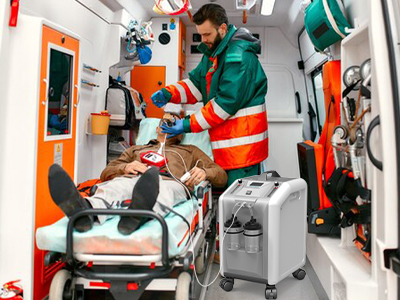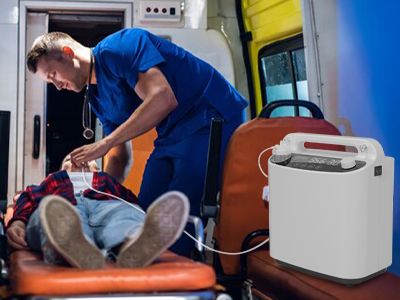15 Dec 2023
Oxygen concentrators in ambulances ensure a steady and reliable supply of oxygen, providing immediate support to patients in transit. They serve as essential devices for delivering therapeutic oxygen.

Preparatory Steps for Oxygen Concentrator Use in Ambulances
A. Safety Precautions and Equipment Check
Before using oxygen concentrators in ambulances, ensuring the functionality of equipment and following safety protocols are crucial. This involves checking connections, power sources, and emergency backup plans.
B. Oxygen Concentrator Setup in Ambulance Environment
Proper installation of oxygen concentrators involves secure placement, proper ventilation, and adherence to operational guidelines within the confined space of an ambulance.
Procedure for Initiating Oxygen Therapy Using the Concentrator
A. Patient Assessment and Oxygen Requirement Determination
Paramedics assess the patient's condition and oxygen needs, determining the appropriate oxygen flow rate based on the severity of the situation and the individual's vital signs.
B. Setting Up and Adjusting Oxygen Flow Rates
After assessment, configuring the concentrator's oxygen flow rate to meet the patient's requirements is critical. Paramedics adjust the settings to ensure an optimal and safe level of oxygen delivery.
Monitoring and Adjusting Oxygen Delivery
A. Continuous Patient Assessment during Transit
While en route, continuous monitoring of the patient's vital signs and oxygen saturation levels is essential. Paramedics stay vigilant for any changes in the patient's condition that may necessitate oxygen flow adjustments.
B. Making Necessary Adjustments for Oxygen Flow
Paramedics need to adapt oxygen flow rates promptly in response to changes in the patient's condition, ensuring they receive the adequate oxygen required for stabilization.

Handling Oxygen Concentrator Malfunctions or Emergency Scenarios
A. Troubleshooting Common Issues
Paramedics are trained to troubleshoot common concentrator malfunctions promptly. This includes addressing power failures, system errors, or oxygen concentration discrepancies.
B. Emergency Response Protocols for Oxygen Concentrator Failure
In the event of concentrator failure, having backup oxygen systems and swift response protocols in place is critical. Paramedics rely on manual oxygen delivery methods to ensure patient safety.
Collaboration and Communication among EMS Team Members
A. Coordinating Efforts in Oxygen Administration
Effective teamwork among EMS personnel is vital for seamless oxygen administration. Clear roles and coordinated efforts ensure a cohesive approach to patient care.
B. Effective Communication for Seamless Patient Care
Communication between paramedics, dispatchers, and medical facilities is crucial for providing timely updates and ensuring a smooth transition of care.
Ensuring Proper Disposal and Maintenance Post-Use
A. Disinfection and Cleaning Procedures
Following the use of oxygen concentrators, thorough cleaning and disinfection protocols are essential to prevent contamination and maintain hygiene standards.
B. Maintenance Checklist for Reusing the Equipment
Regular maintenance schedules, including equipment checks and servicing, ensure the reliability and functionality of oxygen concentrators for future use in emergency scenarios.
Conclusion: The Vital Role of Oxygen Concentrators in Emergency Ambulance Care
Oxygen concentrators serve as indispensable tools in emergency medical services, providing critical oxygen support during transit. Their proper use, maintenance, and integration into EMS protocols ensure optimal patient care and support during critical moments of need.
Keywords: oxygen concentrator
Originally published 15 Dec 2023, updated 15 Dec 2023.